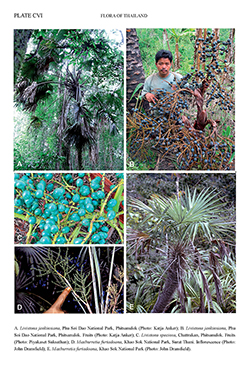e-Flora of Thailand
Volume 11 > Part 3 > Year 2013 > Page 450 > Arecaceae > Maxburretia
1. Maxburretia furtadoana J.Dransf.wfo-0000238118
Gentes Herb. 11: 195. 1978. Plate CVI: D & E.
Accepted Name : This is currently accepted.
Description : Clustering dioecious palm, rarely with more than 10 stems. Stem up to 3(–5) m tall at maturity, ca 5 cm diam., naked proximally, with close leaf sheath scars and vertical cracking, covered distally for 1-2 m with persistent, spine-like leaf sheath fibres. Leaf: petiole up to (20–)30–50(–70) cm long, cross-section subcircular basally to oval distally, 0.3–0.5 cm diam.; blade rounded in outline, flattened, up to 75 cm diam., spilt into 25-30 single-fold segments, splits longest about ½ radius in the distal part, individual segments with 1–5 cm long indentations, pale green above, covered with thin white wax below. Inflorescence 25–40 cm long, with 3–5 first order branches rachillae to 4 cm long; male inflorescence branched to three orders, male flowers solitary or in groups; female inflorescence branched to 2 orders, flowers solitary. Flower ca 0.25 cm long, male flower with 0.1 cm long staminal tube and 0.5 mm long pistillode; female flower with flattened, ca 0.3 mm long staminodes and ca 0.15 cm long gynoecium. Fruit narrowly ovoid, ca 0.8 by 0.4 cm, yellowish-brown at maturity.
Thailand : PENINSULAR: Surat Thani (type: Dransfield 2349, holotype -K).
Distribution : Endemic to Peninsular Thailand.
Ecology : Restricted to exposed summits and sides of large karst limestone outcrops, to 800 m alt.
Vernacular : Mak phra rahu (หมากพระราหู)(Bangkok); palm phra rahu (ปาล์มพระราหู)(Surat Thani).
Uses: Ornamental.
Conservation Status: Despite being restricted to inaccessible limestone crags, the palm has been over-collected, by removal of whole plants from the wild; fire started by man or by lightning can affect such limestone hills and the palm is thus vulnerable.
Notes: An unmistakable palm with its clustering stems and spine-like leaf sheath fibres

